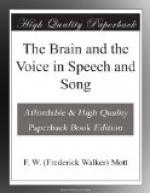It seems, then, that originally man had two languages at his disposal which he used simultaneously or interchangeably. They supported each other in the intercommunication of ideas, but speech has triumphed because of its greater practical utility. The language of gesture is disadvantageous for the following reasons: (1) it monopolises the use of the hands; (2) it has the disadvantage that it does not carry any distance; (3) it is useless in the dark; (4) it is vague in character; (5) it is imitative in nature and permits only of the intercommunication of ideas based upon concrete images. Speech, on the other hand, is transmitted in the dark and with objects intervening; moreover, distance affects its transmission much less. The images of auditory and visual symbols in the growth of speech replace in our minds concrete images and they permit of abstract thought. It is dependent primarily upon the ear, an organ of exquisite feeling, whose sensations are infinite in number and in kind. This sensory receptor with its cerebral perceptor has in the long process of time, aided by vision, under the influence of natural laws of the survival of the fittest, educated and developed an instrument of simple construction (primarily adapted only for the vegetative functions of life and simple vocalisation) into that wonderful instrument the human voice; but by that development, borrowing the words of Huxley, “man has slowly accumulated and organised the experience which is almost wholly lost with the cessation of every individual life in other animals; so that now he stands raised as upon a mountain-top, far above the level of his humble fellows, and transfigured from his grosser nature by reflecting here and there a ray from the infinite source of truth.” Thought in all the higher mental processes could not be carried on at all without the aid of language.
Written language probably originated in an analytical process analogous to the language of gesture. Like that, it: (1) isolates terms; (2) arranges them in a certain order; (3) translates thoughts in a crude and somewhat vague form. A curious example of this may be found in Max Mueller’s “Chips from a German Workshop,” XIV.: “The aborigines of the Caroline Islands sent a letter to a Spanish captain as follows: A man with extended arms, sign of greeting; below to the left, the objects they have to barter—five big shells, seven little ones, three others of different forms; to the right, drawing of the objects they wanted in exchange—three large fish-hooks, four small ones, two axes, two pieces of iron.”
Language of graphic signs and spoken language have progressed together, and simultaneously supported each other in the development of the higher mental faculties that differentiate the savage from the brute and the civilised human being from the savage. In spoken language, at any rate, it is not the vocal instrument that has been changed, but the organ of mind with its innate and invisible molecular potentialities, the result of racial and ancestral experiences in past ages. Completely developed languages when studied from the point of view of their evolution are stamped with the print of an unconscious labour that has been fashioning them for centuries. A little consideration and reflection upon words which have been coined in our own time shows that language offers an abstract and brief chronicle of social psychology.




